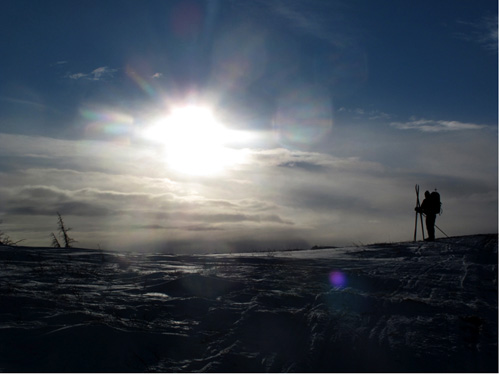
Dramatic report card for the Arctic in 2012By NED ROZELL
January 02, 2013
2012 was a year of “astounding” change for much of the planet north of the Arctic Circle, said four experts at a press conference here at the Fall Meeting of the American Geophysical Union, a five-day gathering of more than 20,000 scientists that ended Dec. 7, 2012. The Arctic as a whole had less snowcover in 2012, among other large changes.
“Snow and ice aren’t just good reflectors, they’re great reflectors,” said Don Perovich of the U.S. Army Corps of Engineers. “And that mirror is breaking.” “By changing global reflectivity, you’re changing the thermostat for the global climate system,” said Martin Jeffries, Program Officer and Arctic Science Advisorwith the Office of Naval Research (on leave from his position as a sea ice researcher at the University of Alaska Fairbanks’ Geophysical Institute). Northern warming “influences mid-latitude weather and storms,” said Jim Overland of the Pacific Marine Environmental Laboratory, who spoke from the audience during the press conference. “It creates a more wavy jet stream.” “Every year is having different types of extreme weather and climate events,” said NOAA Administrator and Under Secretary of Commerce for Oceans and Atmosphere Jane Lubchenco. She mentioned droughts in the U.S. and Superstorm Sandy as examples, but didn’t relate them to changes in the Arctic. Instead she made a baseball analogy, saying that while it would be impossible to say a player hit a particular home run because he was taking steroids, the use of steroids makes hitting a home run more likely. “Storms are taking place today in a climate-changed world,” she said. Jason Box of Ohio State University has studied Greenland for 20 years. In 2012 he observed with the rest of the world the first known time the entire ice sheet — including the highest elevations — got warm enough for ice to melt. “2012 was an astounding year, especially in summer,” he said, adding that the surface of the ice sheet is also getting darker, possibly with soot from tundra wildfires. The researchers also mentioned biological changes in the Arctic, with very low populations of lemmings in Sweden, Finland and Norway, possibly related to a lack of snow that protects it. Years between the population highs and lows of lemmings also seem to be lengthening there. This might be in part responsible for a steep decline in Arctic foxes, of which there may be less than 200 in Sweden, Finland and Norway, compared to more than 15,000 in 1850. With these and other examples, the panel of experts agreed that the Arctic continues to be one of the most rapidly changing regions on Earth. “The Arctic continues to grow warmer at twice the amplitude of lower latitudes,” Jeffries said. “If we’re not already there, we’re surely on the verge of seeing a new Arctic.”
This column is provided as a public service by the Geophysical Institute, University of Alaska Fairbanks, in cooperation with the UAF research community.
E-mail your news &
photos to editor@sitnews.us
|
||
